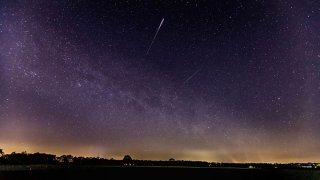
A meteor of the lyrids in the sky is seen on April 22, 2020 in Schermbeck, Germany.
What's happening in the skies over North Texas this month? April holds some spectacular sights in the night sky. Check out the list below.
FULL PINK MOON
The April full moon, known as the Pink Moon, will make for a fully illuminated delight on April 6th at 11:34 p.m. CDT.
Get DFW local news, weather forecasts and entertainment stories to your inbox. Sign up for NBC DFW newsletters.
The name, Pink Moon, takes its name from a type of pink flower known as Phlox subulata - also called pink or moss phlox - that blooms in spring.
Also, catch out other phases of the moon this month. By the way, on April 15th at 9:25 p.m. CDT, the Moon will be at perigee, its closest to the Earth for this orbit at 225,623 miles. On April 28th at 1:44 a.m. CDT, the Moon will be at apogee, its farthest from the Earth for this orbit at 252, 088 miles.
WHEN DOES THE INTERNATIONAL SPACE STATION FLY OVER NORTH TEXAS?
The International Space Station will make flybys across the North Texas sky this month. The ISS appears as a fast-moving star across the night sky.
The International Space Station rotates around the Earth at a speed of 17,500 mph. The ISS rotates about its center of mass at a rate of about 4 degrees per minute so that it will complete a full rotation once per orbit. This allows it to keep its belly towards the Earth. One revolution around the planet takes about 90 minutes (16 per day).
Local
The latest news from around North Texas.
Also, the International Space Station lies at an altitude of 250 miles above the Earth. By the way, that is 1.32 million feet. Most commercial airplanes fly between 33,000 to 42,000 feet.
EVENING PLANETARY DELIGHT: MERCURY, VENUS AND MARS
Right after sunset, look in the western sky to see three planets. Mercury (second brightest) at 6 degrees above the west-northwestern horizon will appear the lowest. On April 11th, Mercury will be at its highest above the west-southwestern horizon (7 degrees) as evening twilight ends at 7:41 p.m. CDT.
Venus (the brightest - Evening Star) at 24 degrees will be above the western horizon. Meanwhile, Mars (third brightest) will appear at 62 degrees above the west-southwestern horizon.
Mercury's distance from the Earth varies from 48 million miles to 137 million miles. Venus's distance from the Earth varies from 24 million miles to 162 million miles. Mars averages a distance from the Earth of 140 million miles. The closest recorded distance to Mars from Earth was recorded in August 2003 when the two were 34.8 million miles apart. According to NASA, the two will not be that close again until the year 2237.
MORNING PLANETARY SURPRISE: SATURN
The only planet visible will be Saturn at 7 degrees above the east-southeastern horizon.
Saturn's distance varies from the Earth. When the two are closest, they lie approximately 746 million miles apart, or eight times the distance between the Earth and the Sun.
At their most distant, when they lie on opposite sides of the Sun from one another, they are just over a billion miles apart, or 11 times the distance between the Earth and the sun.
MONTHLY METEOR SHOW: THE LYRIDS
The April Lyrids are expected to be active between April 16th and 25th, peaking on 11:45 p.m. CDT. on April 22nd. The peak will make about 18 meteors per hour visible.
The expected rate and brightness of these meteors are low enough that Dallas-Fort Worth Metroplex watchers will have little chance of seeing these meteors. You are more likely to see them if you have an unobstructed view with clear skies in a very dark place far from any urban light sources.
The Lyrids will appear to radiate out from near the Lyra Constellation, which contains the bright star Vega. Look above the northeastern horizon after about 10:30 p.m. CDT.
The Lyrids are caused by debris from comet C/1861 G1 (Thatcher) entering the Earth's atmosphere at 110,000 miles per hour.
Please enjoy these events happening in the night sky this month. Until then...Texans, keep looking up!